NOTICE: This post references card features that have changed, expired, or are not currently available
On the most recent Frequent Miler on the Air Podcast: Bucket List Awards Greg daydreamed about the Tambo del Inka, a Marriott Luxury Collection resort in Sacred Valley Peru right along the train route to Machu Picchu. In Greg’s words, this property made it onto his bucket list because “the idea of having such a nice place as a kick off to a Machu Picchu adventure sounds terrific.” Reading the resort’s description of this private train experience, I have to heartily agree with Greg.
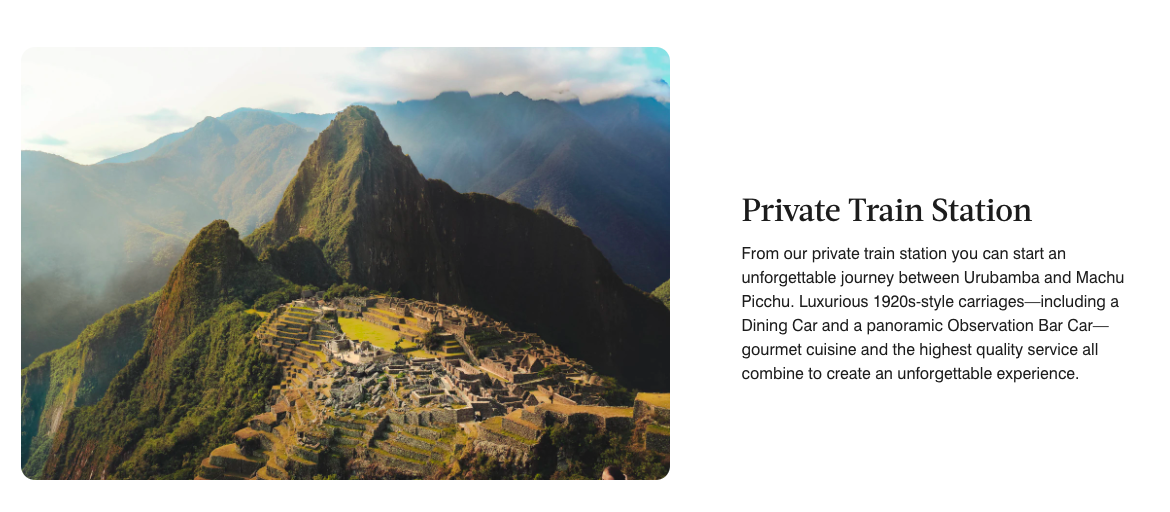
But in 2012 I got to experience a trip like this… and when I say “like this”, I really mean “the exact opposite of this”. Gather ’round the fire and listen to this scary tale, void of any luxuries points and miles can grant us.
See, there are several ways to get to Machu Picchu, some of them more glamorous than others.
1.) Much like the private version offered by the Tambo del Inka, you can take the PeruRail train or IncaRail train which I hear is wonderfully direct, but somewhat expensive. The cost can be as low as $35 per person one way if you book last minute in slow season, but typically closer to $75 a person, one way.
2.) You can also do the Incan trail trek. There are a slew of options for this multi-day hike costing anywhere from $200 to $4,000 and ranging in epic-ness. Honestly it would be incredible to do this someday, but in 2012 when I was in Peru, my husband and I were averaging a budget of ~$7 a day, not $100. So $400 sounded impossibly expensive for a 4 day trek. (This is the true adventurer’s option, though, so I’d love to hear from anyone who’s done it.)
3.) Then there is the “alternative” way which I believe was mentioned in one of the versions of Lonely Planet’s Peru Guide, though we heard of it from a traveler who’d done it before the Lonely Planet ever mentioned it (…y’know…before it was cool.)
The “alternative” route is uncomfortable, grueling, hair-raising, tedious and yet probably one of the cooler adventures I’ve experienced. After all, often the “uncomfortable” and “adventurous” overlap.
To help explain this adventure, I’ve drawn out a little diagram you can use to help you picture the 5 steps involved in the “alternative route”.
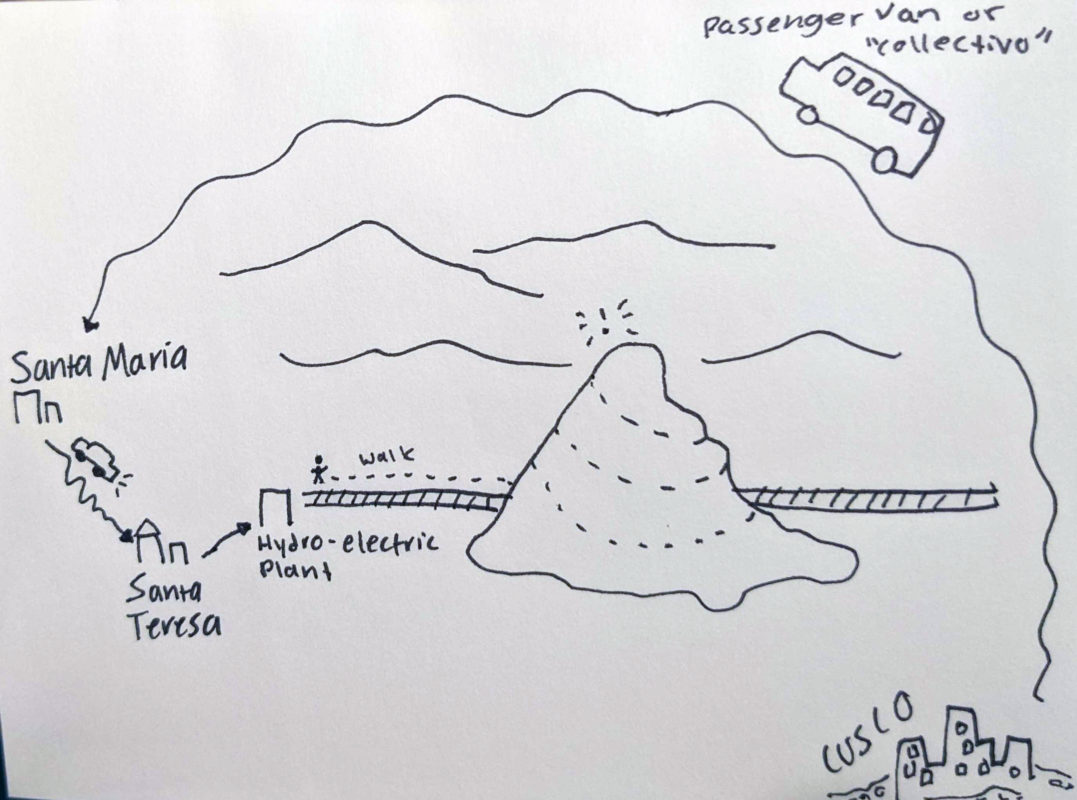
1.) Passenger van from Cusco to Santa Maria
On a specific street beside the bus station in Cusco, there are passenger vans (or “colectivos” as they’re sometimes called) lined up and waiting for passengers. Each colectivo seems to have a person dedicated to the task of filling it up. We didn’t have to bother finding the right van or the right representative, however, because as soon as the locals saw a group of tourists step out of the taxi, they immediately guessed which van we wanted. In no time we were swarmed with people shouting their offers for a ride to Santa Maria. The price we settled on? $9 per person.
The van ride was uncomfortable to say the least. We were squeezed tightly together and it was clear that the driver had no intention of stopping at all throughout the day-long trip. That is… until the brakes started smoking. THEN we pulled over for a break.
2.) Taxi from Santa Maria to Santa Teresa
It may have grown in the last decade, but at the time Santa Maria looked to be nothing more than an empty street and a hybrid corner-store/restaurant. It looked fearfully empty and yet, luckily, a few taxi drivers were waiting for the colectivo’s arrival. The taxi drive from Santa Maria to Santa Teresa was much shorter…and much more harrowing. We spent the whole drive at the mercy of our fearless driver who seemed quite unconcerned about the sheer cliffside and narrow road. The view would have seemed amazing had it not looked so much like certain death.
3.) Taxi from Santa Teresa to Hydro-electric plant
After spending the night in Santa Teresa, we woke early the next morning and grabbed a taxi to the hydro-electric plant where we could hop on a train to Aguas Calientes, the town at the bottom of Machu Picchu. Or at least we would have been able to hop on the train if we had arrived in time. But we didn’t. We arrived just in time to see the last train of the morning pull away, just before 8 am.
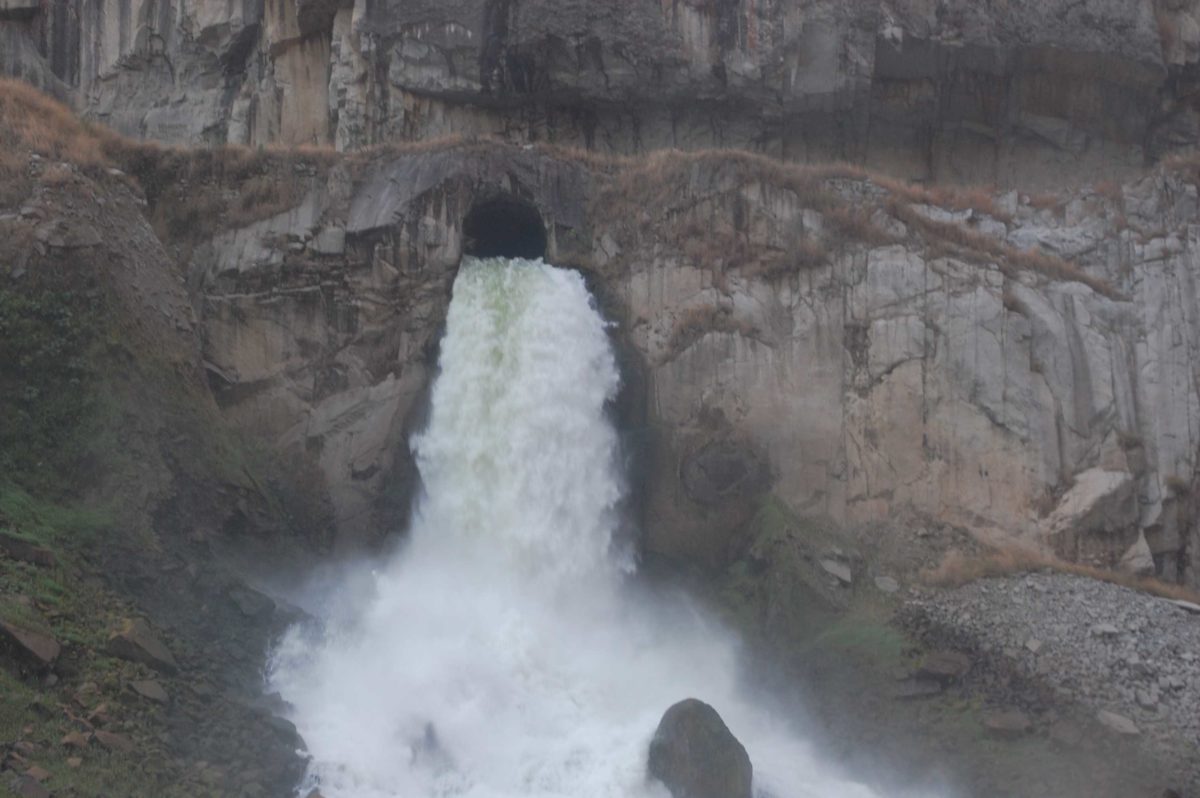
4.) Walk (or train if you arrive in time) from the hydro-electric plant to Aguas Calientes.
So instead of taking a brief train ride from the hydro-electric plant to Aguas Calientes, we took to the train tracks by foot. This took 2 to 2.5 hours and I must say, even if it wasn’t entirely intentional, it was beautiful and serene.
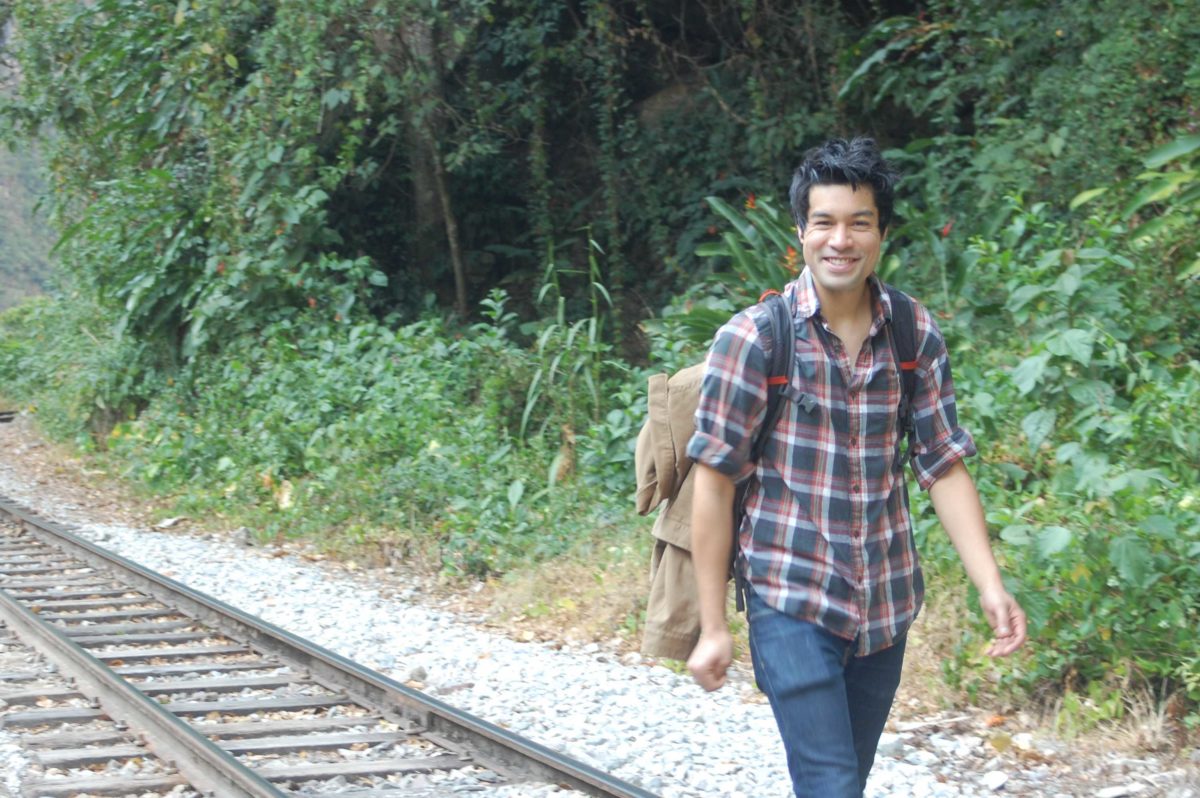
5.) Bus (or walk if you want) from Aguas Calientes to the entrance of Machu Picchu.
Finally once we arrived at Aguas Calientes, we bought our Machu Picchu tickets – (you can’t buy them at the peak entrance) – and took a brief ten minute bus ride to the top of Machu Picchu. After our two and a half hour trek, we were ok with skipping the many stairs involved in walking up the mountain, though this would have been an option as well.
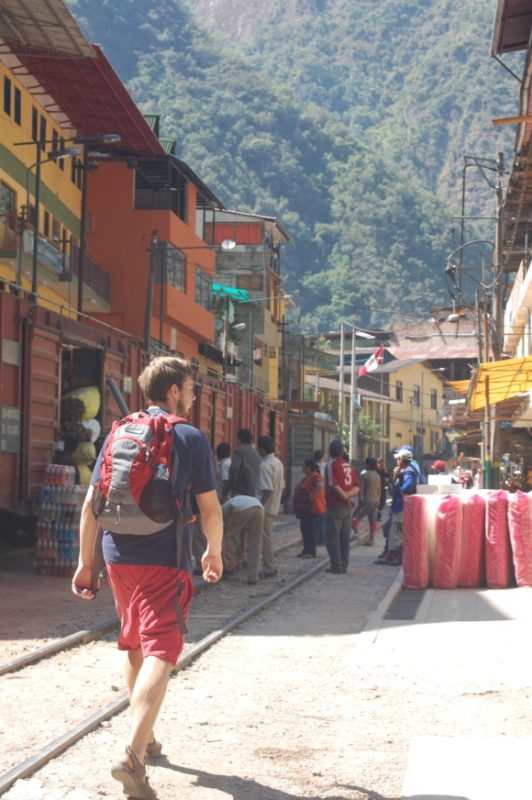
Not the serene and exclusive experience promised by the Tambo del Inca, but this chaptered alternative method felt like a journey worthy of an ancient citadel. By the time we stood at the top of that incredible mountain, we felt like we had worked our way there one little segment at a time. For this reason, I can’t possibly regret our back-way journey to Machu Picchu, but at the same time…it sure would make me appreciate the Tambo del Inka’s private train.


I went 3x: first by train, second we walked the Inka Trail from 100 in one day, third that night we climbed the stairs and entered in the dark! amazing! we were celebrating my 40th year
This bacl way is no
Longer cheap because people feel the need to blab about it on the internet
people were writing it in guidebooks long before
Did the trek and it was epic. Being the first ones through the Sun gate and watching the Sun come up over Machu Pichu is a tough feeling to describe. We used Alpaca Expeditions and they were incredible.
I did precisely this! Except, I had my own transportation: I was on a motorcycle. So I did the extremely harrowing twisty roads with no guardrails and 600 ft drops. We had one crash on the way which resulted in an end of life scenario, however the fall was only about 6 feet off the cliff.
This was such an authentic way to approach Machu Picchu. Climbing up through hand hewn Rock steps that were who knows how many hundreds of years old. We hiked up l, amid a light rain pattering on the jungle leaves. We felt like Indiana Jones solo trekking into mysterious unknowns. And, of course, at the end of the day, we did the reverse hike all the way back to the hydroelectric plant.
When I went there in 2010, I did something similar. Many of the travel agents there would advertise something called the “Inca Jungle trail”, that followed a similar route but starting with a downhill bike, some trail hiking and then following the tracks at the end like you describe. Back then it was $200, more of course than what you did but still a pretty decent deal (and much cheaper than the real inca trail). Was a good time.
Found a link with the route.
https://www.machupicchutrek.net/hike-to-machu-picchu/inca-jungle-trek/
I think I’ll take a pass on That but love the link..They tell u everything and not that many $$$..
Hoping to find the next harder trail up from Diamond Head Loved it !!!I emailed a trail club for help so will see.
Thanks
Showing my age, but I think it’s an interesting story anyway. In 1977, on a tip from another backpacker, I stopped by the Cuzco train station mid-afternoon and struck up a conversation with the station chief. Explaining that I was a university student on a tight budget, he smiled and told me to be at the station at 5:00 am the next day. Back then there was an early morning train for employees at Machu Pichu. Since few if any people living near the park spoke Spanish (only Quechua), the park employees commuted from Cuzco. In summary, I was able to explore the park that was practically empty of tourists. The round trip fare was about US$ 5.00. To this day I remember the station manager and his pride as a Peruvian to help a young foreigner learn something of the Peruvian heritage.
Like the drawing and easy to follow. Enjoy the story!
Thank you Caroline. I really enjoyed the article and everything else you bring to FM. I would love it if FM found a way to feature you more. There is lack of female perspective in the hobby and one of my favorite points/ miles podcasts episodes ever was when Drew had you on to talk about your adventures or mis-adventures 🙂
Did the 4 day/3 night track back in 2011. I was in good physical shape and did not have any altitude problems but the track was quite exhausting. It’s 8 hours a day for three days going up and down, up and down. Then last day you get up 4am to make the last couple of hours and be at the site by sunrise, trying to beat other groups on the way. Clearly everyone is happy but tired and the actual experience of exploring the site could probably be better without the Trail. I’m glad I did the Trail but later on I learned about a 2 days/1night shortcut and that’s probably how I’d do it now.
I recommend the 5 day hike. 95+% take the 4 day and force march ahead in a big scrum on day 2. We were the only 5 day group so had everything to ourselves.
5 day hike option is far more relaxing – you get the campgrounds to yourself and can use alternate campsites. Also get more chances to explore the ruins. Porters are amazing and we enjoyed some of the best food I had in Peru.
Top tip (if you can afford it) is to stay at the Belmond hotel (only accomodation at the top – you avoid the massive bus lines and are only a few hundred feet from the entrance) rather than down in Aguas Calientes. Avoid the rooms in the front as the buses stop and turn around starting early in the AM.
If staying at the Belmond, great to just walk down to the hotel, get a shower after 5 days on the trail. Fantastic views from the hotel and allows you to stay after all the tourists head down the mountain. Also you get head start to see the sunrise if it’s a clear day. Wayna Pichu is also a great day hike – make sure to reserve in advance.
Stayed at Inka del Tambo – nice hotel – glaciers on mountains above were unexpected. The Marriott (El Convento?) in Cusco was great value and centrally located – recommended.
The way both you and Greg talk about the Urubamba PeruRail extension as a “private train” is not accurate. It is a publicly accessible train, just like the route back to Cusco. The only thing “private” is that there is a station directly at the Tambo del Inka resort for hotel guests, but after a few minutes once the train leaves the resort grounds, it stops at the public Urubamba station. So, it’s not more private or luxurious than just taking the train from Cusco, but it is a hell of a lot more convenient to just walk over to the station from the hotel than compared to the taxi ride needed from central Cusco to the Poroy station.
I was wondering about that! I noticed that in one part of the description it says “private train station”. Helpful clarification! Thank you!
Good clarification, thank you! Just for the record, I described it as a private train station, not a private train: https://frequentmiler.com/my-most-anticipated-award-stays/#6_Tambo_del_Inka_a_Luxury_Collection_Resort_Spa_Sacred_Valley_Peru 🙂
Awesome story, Caroline. I took my wife to Peru for her 30th birthday and it was quite an epic adventure. We spent a few days in Cusco and the Sacred Valley then did the 8 day Salkantay Trek to Machu Picchu. It was quite intense with a lot of elevation climb. I think we were at an elevation of 15,200 feet at the mountain pass. It was amazing. Then we trekked through the Amazon cloud forest and on to Machu Picchu. All meals were provided by our personal cooks and camping gear was transported by our porters. Our tour guide was amazing. We did trek through Valencia Travel Cusco and got a really good discount by purchasing through theclymb.com. What an unforgettable experience!!! 🙂
Did the trek and it was epic. Being the first ones through the Sun gate and watching the Sun come up over Machu Pichu is a tough feeling to describe. We used Alpaca Expeditions and they were incredible.
We ran the Inca Trail end to end into Macchu Pichu in one day during the Inca Trail Marathon, it was pretty epic. Getting to see ruins along the trail on your own is a lot more special than the huge crowds at Macchu Picchu. The walking trek would be pretty epic. The porters are amazingly strong people. I highly recommend both the Trek and the marathon. It’s very tough though. I hope I can get back into that shape.
Awesome story, thanks for sharing! Sounds like quite an adventure – if a lot more walking than you planned
I’ve never thought about visiting Machu Picchu but maybe I should consider a trip in the off season – especially since coming from Mexico City I shouldn’t have any altitude issues. (I’ll probably take the train and stay at the fancy hotel though…)
Also FYI there’s only one L in colectivo
Oh thank you! I’ll update that spelling. 🙂
Carrie!! Loved reading your journey to Machu Picchu. Hopefully you have a few more stories to share in future blog posts 🙂
For the record, this is how I went to Machu Picchu: Lima to Cusco by plane, then to Aguas Caliente by train, then bus to the top of Machu Picchu. Quite enjoyable 🙂